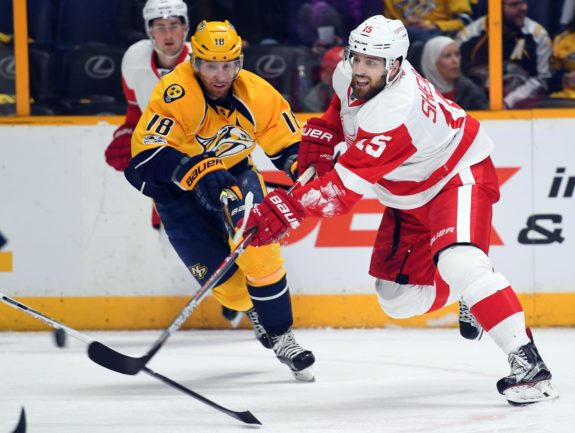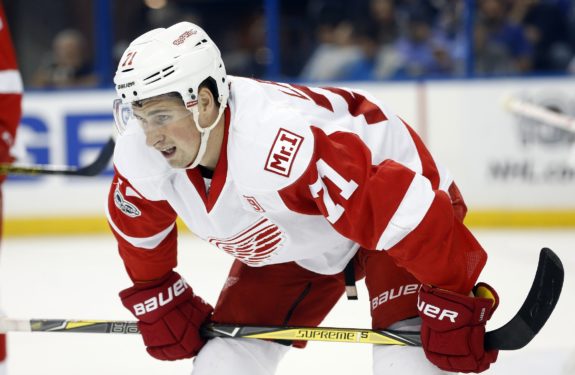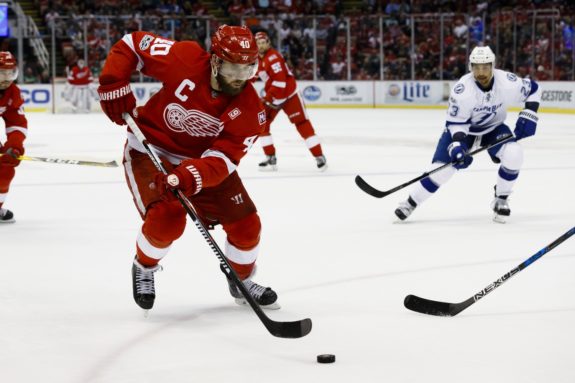Scoring goals was not the strong point of the Detroit Red Wings last season. Their paltry 2.4 goals per game pace was fifth-worst in the NHL. Moreover, their power play sustained dry spells not normally seen outside of the Sahara.
It was a tough year all around for the Red Wings. And though they bring back much of the same roster as the 2016-17 season, there is hope. When the majority of your team underperforms one year, a couple things can happen the next. They can either improve to a point closer to what’s expected—scoring at a pace more similar to their expected shooting percentage—or continue to struggle until changes are made. The goal of those changes would be to return to the former path.

With regard to scoring at a more expected pace, there are a few things working in Detroit’s favor. And if the Red Wings can indeed score more, perhaps they can win a few more games this year.
Shooting Percentage Fluctuations
While the Red Wings were outshot most of last season, they really did not have much luck with the shots they were able to put on net. According to Hockey-Reference.com, the Red Wings only scored on 8.5 percent of their shots on net, compared to the league-wide 9.2 percent shooting percentage. As part of this, a few players were more snake-bitten than others.
It’s no secret that Riley Sheahan was unlucky last season. But apart from the former Notre Dame forward, Dylan Larkin, Gustav Nyquist, and Justin Abdelkader—key cogs up front—also suffered in the scoring department.
| Player | 2016-17 Goals | 2016-17 Shooting Percentage | Career Shooting Percentage |
| Justin Abdelkader | 7 | 6.7% | 8.8% |
| Dylan Larkin | 17 | 9.6% | 10.0% |
| Gustav Nyquist | 12 | 7.3% | 11.9% |
| Riley Sheahan | 2 | 1.8% | 9.0% |
Keeping all other factors consistent (shot location, opponent quality, goaltender position), these players should have scored more last season. Larkin’s shooting percentage wasn’t far off from the previous year—he was just expected to take a step forward rather than regress after gaining more NHL experience. The others needed to score more, but didn’t for a variety of reasons.

If you take the law of averages seriously, then you can expect these four to score closer to their career clips this coming season. Sure, the four are a year older, but none are at a point where you’d expect a significant decline. Much like you’d expect Andreas Athanasiou’s phenomenal shooting percentage to regress this year—if he plays—you can also expect others to rebound after an unlucky previous season.
Power Plays on the Rise
It’s been a hot topic throughout the preseason: Penalties are easier to take than ever before. Players are taking delay-of-game penalties for faceoff violations and it really doesn’t take much to be called for slashing now. Just ask Pittsburgh’s Zach Trotman:
"Slashing" pic.twitter.com/eosnSJ37eH
— Zach Trotman (@Ztrotman4) September 21, 2017
Until players adapt to the NHL’s new rules, teams will see an increase in the amount of power plays they’ll receive each game. As I mentioned before, Detroit’s power play was abysmal at times, but it should also be noted that they finished on a high note. During March and April, their conversion rate on the man advantage ranked 10th in the NHL. If that success can carry over to the new year, Detroit will surely score more over the course of the season.
Red Wings Player Usage
So far this preseason, we’ve seen Dylan Larkin and Anthony Mantha together on a line and the two have responded. Detroit’s young stars have a chance to be great and could use their speed to produce for the Red Wings.
Having a second scoring line will take the pressure and sole focus off Henrik Zetterberg and his wingers. Additionally, Detroit won’t need to play Zetterberg 20-plus minutes every night to keep pace with their opponents if Larkin and Mantha’s line is contributing. Even the third line of Frans Nielsen, Darren Helm, and potentially Andreas Athanasiou can be dangerous. The three would match up well with bottom-six lines across the league.

The key here is for the Red Wings to stay healthy. If they can roll out these lines and keep a somewhat clean bill of health rather than pace the league for man-games lost, they’ll certainly score more.
Better puck luck, more power plays, and staying healthy will help the Red Wings improve in the goal-scoring department. Preventing goals against is a different story…